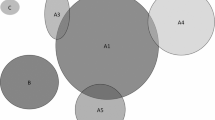Abstract
A consistent terminology for species diversity is subject of an ongoing debate. Recently Tuomisto (Oecologia 164:853–860, 2010) stated that a consistent terminology for diversity already exists. The paper comments on recent papers by ourselves (Jurasinski et al. Oecologia 159:15–26, 2009) and by Moreno and Rodriguez (Oecologia 163:279–282, 2010). Both started from Whittaker’s diversity concept to discuss the ambiguities of the terminology and propose a new, more consistent terminology that is based on the different approaches to diversity analysis. In contrast, Tuomisto adheres to a strict school of thinking and derives a diversity framework in the sense of Whittaker (alpha, beta, gamma) from the conceptual definition of diversity itself. A third group of papers discusses appropriate methods for the analysis of the variation in species composition. Here, we support the idea that alpha, beta and gamma diversity should be used in a strict sense that is based only on the conceptual definition of diversity. We accordingly extend and modify our terminological concept for species diversity. All approaches to the analysis and quantification of species composition and diversity can be assigned to three abstraction levels (species composition, variation in species composition,and variation in variation in species composition) and two scale levels (sample scale, aggregation scale). All methods that investigate the variation in species composition across scale levels evaluate beta relation with beta diversity being just one form of beta relation, which is calculated by dividing gamma diversity of order q by the appropriate alpha diversity of the same order. In contrast, differentiation refers to a pairwise calculation of resemblance in species composition. It is restricted to sample scale and is therefore most often only an intermediate step of analysis. Many ecological questions can be addressed either by direct analysis of the variation in species composition using raw data approaches or by further analysis of differentiation datasets on aggregation scale with or without respect to an external gradient.

Similar content being viewed by others
References
Anderson MJ, Crist TO, Chase JM, Vellend M, Inouye BD, Freestone AL, Sanders NJ, Cornell HV, Comita LS, Davies KF, Harrison SP, Kraft NJB, Stegen JC, Swenson NG (2011) Navigating the multiple meanings of beta diversity. a roadmap for the practicing ecologist. Ecol Lett 14:19–28
Baselga A, Jiménez-Valverde A, Niccolini G (2007) A multiple-site similarity measure independent of richness. Biol Lett 3:642–645
Chao A, Jost L, Chiang SC, Jiang Y-H, Chazdon RL (2008) A two-stage probabilistic approach to multiple-community similarity indices. Biometrics 64:1178–1186
Diserud OH, Ødegaard F (2007) A multiple–site similarity measure. Biol Lett 3:20–22
Hill MO (1973) Diversity and evenness: a unifying notation and its consequences. Ecology 54:427–432
Janson S, Vegelius J (1981) Measures of ecological association. Oecologia 49:371–376
Jost L (2006) Entropy and diversity. Oikos 113:363–375
Jost L (2007) Partitioning diversity into independent alpha and beta components. Ecology 88:2427–2439
Jost L (2009) Mismeasuring biological diversity: response to Hoffmann and Hoffmann (2008). Ecol Econ 68:925–992
Jost L (2010) Independence of alpha and beta diversities. Ecology 91:1969–1974
Jurasinski G, Retzer V, Beierkuhnlein C (2009) Inventory, differentiation, and proportional diversity: a consistent terminology for quantifying species diversity. Oecologia 159:15–26
Jurasinski G (2011) simba: A collection of functions for similarity analysis of vegetation data. R package version 0.3-3. http://CRAN.R-project.org/package=simba
Jurasinski G, Jentsch A, Retzer V, Beierkuhnlein C (2011) Detecting spatial patterns in species composition with multiple plot similarity coefficients and singularity measures. Ecography. doi: 10.1111/j.1600-0587.2011.06718.x
Koleff P, Gaston KJ, Lennon JJ (2003) Measuring beta diversity for presence–absence data. J Anim Ecol 72:367–382
Laliberté E (2008) Analyzing or explaining beta diversity? Comment. Ecology 89:3232–3237
Legendre P, Legendre L (1998) Numerical ecology, 2nd English edn. Elsevier, Amsterdam
Legendre P, Borcard D, Peres-Neto PR (2005) Analyzing beta diversity: partitioning the spatial variation of community composition data. Ecol Monogr 75:435–450
Legendre P, Borcard D, Peres-Neto PR (2008) Analyzing or explaining beta diversity? Comment. Ecology 89:3238–3244
MacArthur RH (1964) Environmental factors affecting bird species diversity. Am Nat 98:387–397
MacArthur RH (1965) Patterns of species diversity. Biol Rev 40:510–533
Moreno CE, Rodríguez P (2010) A consistent terminology for quantifying species diversity? Oecologia 163:279–282
Pélissier R, Couteron P, Dray S (2008) Analyzing or explaining beta diversity? Comment. Ecology 89:3227–3232
Ricotta C (2005) Through the jungle of biological diversity. Acta Biotheor 53:29–38
Routledge RD (1977) On Whittaker’s components of diversity. Ecology 58:1120–1127
Routledge RD (1979) Diversity indices: which ones are admissible? J Theor Biol 76:503–515
Tuomisto H (2010a) A diversity of beta diversities: straightening up a concept gone awry. Part 1. Defining beta diversity as a function of alpha and gamma diversity. Ecography 33:2–22
Tuomisto H (2010b) A diversity of beta diversities: straightening up a concept gone awry. Part 2. Quantifying beta diversity and related phenomena. Ecography 33:23–45
Tuomisto H (2010c) A consistent terminology for species diversity? Yes, it does exist. Oecologia 164:853–860
Tuomisto H, Ruokolainen K (2006) Analyzing or explaining beta diversity: understanding the targets of different methods of analysis. Ecology 87:2697–2708
Tuomisto H, Ruokolainen K (2008) Analyzing or explaining beta diversity? Reply. Ecology 89:3244–3256
Veech JA, Summerville KS, Crist TO, Gering JC (2002) The additive partitioning of species diversity: recent revival of an old idea. Oikos 99:3–9
Whittaker RH (1960) Vegetation of the Siskiyou Mountains, Oregon and California. Ecol Monogr 30:279–338
Acknowledgments
We thank many colleagues for intense discussions on species diversity, especially Vroni Retzer, John-Arvid Grytnes, Ole Vetaas and Michael Manthey. Comments by an anonymous reviewer and fruitful discussions with Hanna Tuomisto considerably helped to improve the text. All experiments comply with the current laws of the country in which the experiments were performed. The authors declare that they have no conflict of interest.
Author information
Authors and Affiliations
Corresponding author
Additional information
Communicated by Scott Collins.
Rights and permissions
About this article
Cite this article
Jurasinski, G., Koch, M. Commentary: do we have a consistent terminology for species diversity? We are on the way. Oecologia 167, 893–902 (2011). https://doi.org/10.1007/s00442-011-2126-6
Received:
Accepted:
Published:
Issue Date:
DOI: https://doi.org/10.1007/s00442-011-2126-6




